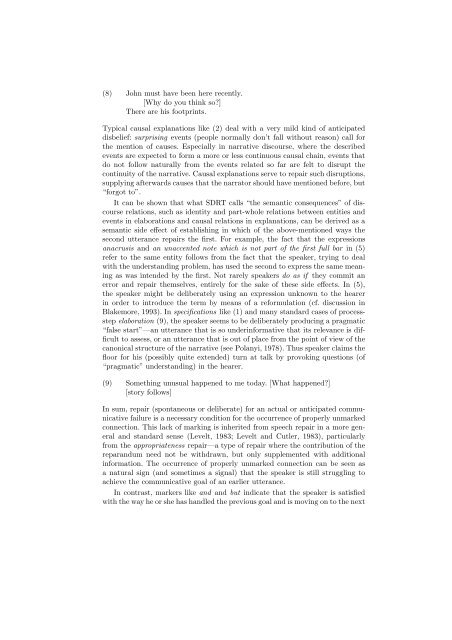Elaboration and Explanation* - Inria
Elaboration and Explanation* - Inria
Elaboration and Explanation* - Inria
You also want an ePaper? Increase the reach of your titles
YUMPU automatically turns print PDFs into web optimized ePapers that Google loves.
(8) John must have been here recently.<br />
[Why do you think so?]<br />
There are his footprints.<br />
Typical causal explanations like (2) deal with a very mild kind of anticipated<br />
disbelief: surprising events (people normally don’t fall without reason) call for<br />
the mention of causes. Especially in narrative discourse, where the described<br />
events are expected to form a more or less continuous causal chain, events that<br />
do not follow naturally from the events related so far are felt to disrupt the<br />
continuity of the narrative. Causal explanations serve to repair such disruptions,<br />
supplying afterwards causes that the narrator should have mentioned before, but<br />
“forgot to”.<br />
It can be shown that what SDRT calls “the semantic consequences” of discourse<br />
relations, such as identity <strong>and</strong> part-whole relations between entities <strong>and</strong><br />
events in elaborations <strong>and</strong> causal relations in explanations, can be derived as a<br />
semantic side effect of establishing in which of the above-mentioned ways the<br />
second utterance repairs the first. For example, the fact that the expressions<br />
anacrusis <strong>and</strong> an unaccented note which is not part of the first full bar in (5)<br />
refer to the same entity follows from the fact that the speaker, trying to deal<br />
with the underst<strong>and</strong>ing problem, has used the second to express the same meaning<br />
as was intended by the first. Not rarely speakers do as if they commit an<br />
error <strong>and</strong> repair themselves, entirely for the sake of these side effects. In (5),<br />
the speaker might be deliberately using an expression unknown to the hearer<br />
in order to introduce the term by means of a reformulation (cf. discussion in<br />
Blakemore, 1993). In specifications like (1) <strong>and</strong> many st<strong>and</strong>ard cases of processstep<br />
elaboration (9), the speaker seems to be deliberately producing a pragmatic<br />
“false start”—an utterance that is so underinformative that its relevance is difficult<br />
to assess, or an utterance that is out of place from the point of view of the<br />
canonical structure of the narrative (see Polanyi, 1978). Thus speaker claims the<br />
floor for his (possibly quite extended) turn at talk by provoking questions (of<br />
“pragmatic” underst<strong>and</strong>ing) in the hearer.<br />
(9) Something unusual happened to me today. [What happened?]<br />
[story follows]<br />
In sum, repair (spontaneous or deliberate) for an actual or anticipated communicative<br />
failure is a necessary condition for the occurrence of properly unmarked<br />
connection. This lack of marking is inherited from speech repair in a more general<br />
<strong>and</strong> st<strong>and</strong>ard sense (Levelt, 1983; Levelt <strong>and</strong> Cutler, 1983), particularly<br />
from the appropriateness repair—a type of repair where the contribution of the<br />
repar<strong>and</strong>um need not be withdrawn, but only supplemented with additional<br />
information. The occurrence of properly unmarked connection can be seen as<br />
a natural sign (<strong>and</strong> sometimes a signal) that the speaker is still struggling to<br />
achieve the communicative goal of an earlier utterance.<br />
In contrast, markers like <strong>and</strong> <strong>and</strong> but indicate that the speaker is satisfied<br />
with the way he or she has h<strong>and</strong>led the previous goal <strong>and</strong> is moving on to the next

















